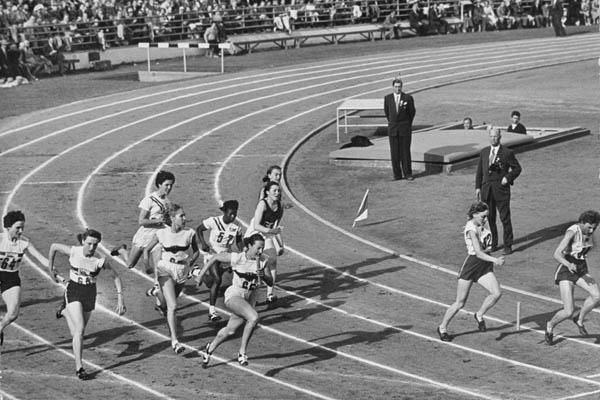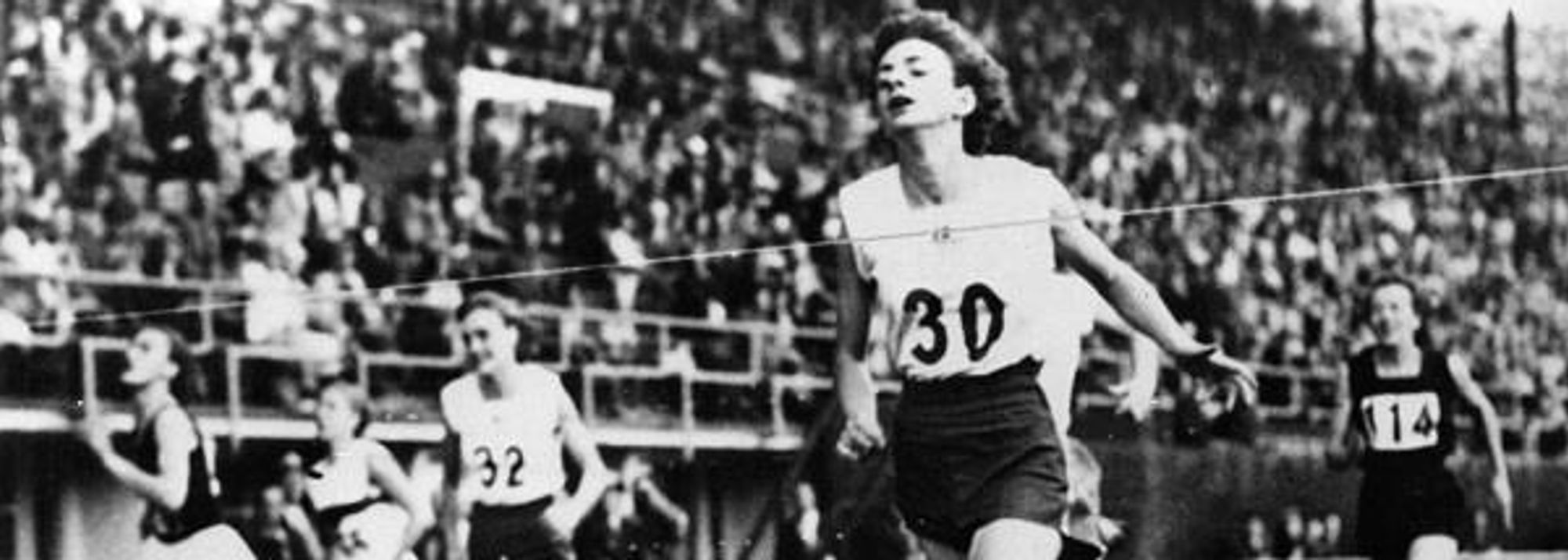Marjorie Jackson at the 1952 Olympic Games
On this day 70 years ago (26 July), Marjorie Jackson flew around the bend of the Helsinki Olympic Stadium on her way to victory in the 200m. Having equalled the world record in the heats and broken it in the semifinals, Jackson now ran 23.7 to win the final by almost five metres.
The win completed an Olympic sprint double. Jackson had won the 100m with similar ease four days earlier, Australia’s first ever women’s Olympic gold medal in athletics. In between the two flat sprints, Shirley Strickland won the 80m hurdles. In winning the 200m, however, Jackson created a significant piece of Australian Olympic history. At the first modern Olympics in Athens in 1896, Edwin Flack had won the 800m and 1500m and now Australia’s first women’s gold medallist likewise completed a golden double.
Jackson could so easily have shared a third Olympic triumph in the 4x100m. Having set a world record in the heats, the Australians were heading for victory at the last changeover in the final. The hand-over apparently ‘complete’, the baton fell after striking the leg of either the incoming Winsome Cripps, or Jackson. Jackson regained it on the bounce, but the USA were away, heading to the gold medal. A few days later, Australia beat the US in another world record (4x110yd) at the traditional British Empire v USA dual match.
World records either side of the Olympic final, then, but no gold medal. It’s a salutary tale that has been told and re-told in Australian athletics ever since.
But it is not the story of Jackson’s success at the Helsinki 1952 Olympic Games; neither should it detract from that success. The trajectory of Jackson’s meteoric rise from promising junior to double Olympic champion and world record-holder, all before turning 21, is full of elements that, frankly, you couldn’t make up.
Setback as an U20 champion? Check. Rise to wider fame by defeating the world’s best athlete? Check. Small-town girl fanatically supported by the locals to the extent of constructing a cinder track where she could train under the headlights of her coach’s car. Check that box, too. Returns from Helsinki having met the love of her life? First woman to be appointed as manager of an Australian Commonwealth Games team? Governor of the state of South Australia? Still going strong at 91? Tick, tick, tick, tick.
Jackson was born at Coffs Harbour on the north coast of New South Wales. Her family moved to Lithgow, in the Blue Mountains some 140km west of Sydney, soon after. For those heading to next year’s World Athletics Cross Country Championships, Lithgow is on the road and rail route to Bathurst.

Jackson showed evident talent as a junior. Her record (accurately) suggests that she is a well-grounded person, though she recalls some wise counsel from her father after she had won a state country title. Everyone had their own special talents, her dad said, and hers seemed to be running. It didn’t make her better than others, but she should develop it.
Jackson’s talents were soon more widely deployed. She won regularly in Sydney competition. But a stumble in the blocks (which she, wrongly, thought would lead to a recall), saw her miss out on an invitation to the final London 1948 Olympic trials.
Lithgow seethed with indignation. Perhaps this motivated supporters to turn up in numbers the following year when Jackson was invited to run against Dutch superstar Fanny Blankers-Koen. Apparently, Blankers-Koen and her husband-coach Jan Blankers were under the impression that her Australian tour would be a largely an exhibition. Shirley Strickland was not at top form and – who else was there, anyway.
Enter 17-year-old Jackson to cause a sensation at the Sydney Sports Ground on 5 February. The next day’s Sunday Herald front page report, with photo, ran: “Marjorie Jackson, 17-year-old Lithgow typist, defeating the Olympic champion, Fanny Blankers-Koen, in a 100-metres race at the Sydney Sports Ground yesterday afternoon.”
A week later, Jackson again defeated Blankers-Koen, this time in the New South Wales 100 yards championship. A Melbourne sports paper published a three-part series on Jackson, who had quickly gathered nicknames - the Lithgow Flash or Lithgow Flier. “Second child of a family of three girls,” the introduction ran, “a frolicsome lass, never still and ran everywhere she went.”
Lithgow was as elated now as it had been despondent a year earlier. The Sunday Herald sports section reported: “Twenty Lithgow miners caused laughter among the crowd … when they wildly cheered Marjorie Jackson after her 100 metres victory.” Deeper down came mention that this celebration occurred at the Sports Ground beer booth.
The contingent caught the train back to Lithgow, arriving at 11pm to find the station thronged with people. Jackson was presented with a huge garland of flowers.
In the run-up to Helsinki, Jackson would have further reason to be grateful for local support. Australia had few cinders tracks. Sydney had one, but that necessitated a 300km round trip. There were cinders aplenty in Lithgow, however: Jackson’s coach – Jim Monaghan, but to this day Mr Monaghan to Jackson – and the miners rolled out a straight section of cinders so that Jackson could train on the sort of surface she would find at the Olympics. Throughout winter, with Lithgow often enshrouded by fog and misty rain, Jackson ran along the track, starting in the pitch dark at one end, running towards the headlights of Monaghan’s car at the other.
It paid off in Helsinki, when rain throughout much of the opening ceremony left the track damper and softer for the heats of the women’s 100m two days later. “Whacko! I’m back in Lithgow,” Jackson thought as she went out to race.

Marjorie Jackson (© Giancarlo Colombo)
Jackson was one of the favourites for the Olympic sprints, but the Australian preparation for the Games had more obstacles than a 3000m steeplechase. The team spent over a month based in London and racing around Britain. They had very little support, the athletes’ daily allowance was 15 English shillings (equivalent to 75 pence now). Jackson recalls that transport to the track and lunch cost around 18 shillings for a net loss of three shillings a day.
The cinder tracks were harder, too. Many of the Australians – Jackson included – ran in spikes hand-made from kangaroo skin by Melbourne shoemaker, Hope Sweeney. The fixed spikes were suited to grass tracks, but too long for harder surfaces. “After a couple of sessions our shins were so sore we could hardly walk,” says Jackson. They persevered. Despite everything, Jackson impressed at every race she ran. A Belfast paper came up with a variation on her nickname. Noting she worked as a typist, the memorably titled Northern Whig and Belfast Post dubbed her “The Typing Tornado”.
Helsinki had suffered in the war years, though not as severely as London. The long daylight hours made sleep difficult for some, but Jackson says the Australian team was “wonderful, like family.” Like many athletes, she found the call room an unnerving experience – “I’m a chatterbox,” she says, “but no-one is talking. I walked out on to the track nattering to myself: ‘I’m as good as they are’.”
She felt the pressure, too. “I felt the whole of Australia was sitting on my back” – but, really, she need not have been bothered. Jackson ran away from her competition, defeating South Africa’s Daphne Hasenjager 11.5 to 11.8 (11.67 to 12.05 electric), Strickland and Cripps. In a post-race interview, Jackson sent a ‘cheerio’ to “Mum and Dad, all the family, Mr Monaghan and the people of Lithgow.”
Jackson went on to complete the double four days later. She returned to a hero’s welcome. Crowds lined the streets and over 20,000 were estimated to have turned out in Lithgow alone.
Jackson also returned with a budding interest in Peter Nelson, a member of the Olympic cycling team. Nelson lived in Adelaide but the romance blossomed by correspondence. They were married in 1953 and together until his early death from leukaemia in 1977. Jackson set up a research foundation in his memory and worked tirelessly to raise funds. As Marjorie Jackson-Nelson, she was South Australian state governor from 2001 to 2007, during which time she took part in the delivery of the Queen’s Baton at the opening ceremony for the Melbourne 2006 Commonwealth Games. Jackson, the penultimate runner, passed the baton to Helsinki teammate and Victorian governor, John Landy.
Athletically, Jackson retired after winning the sprint double at the 1954 British Empire and Commonwealth Games in Vancouver. In her career, she won every individual gold medal – Olympics, Commonwealth, national and state level – that she contested.
“I remember when I got back to Lithgow, Dad said to me: ‘You’re an Olympic champion now and kids will look up to you for the rest of your life’.
“Peter and I both tried to live by the Olympic ideals.”
Len Johnson for World Athletics





